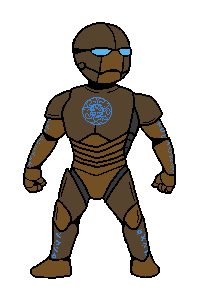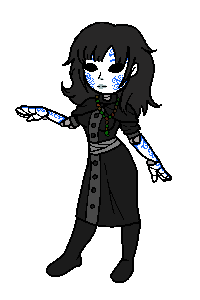| YANTA |
  |
| THE IMAGE OF THEIR CREATORS |
| Yanta are gebbiform in shape and most are built robustly with thick limbs and barrel torsos. Basic models produced in huge amounts for armies during the Gate War are constructed of hardwood with steel joints and plating, with simple hinged mouths and stone eyes. One-off bespoke chassis exist, however, with more advanced clockwork mechanisms, finely molded features, or decorative sculpted ceramic casings. |
| ARTIFICIAL INTELLIGENCE |
| When given life by the anima mill, yanta are blank slates with the physical, mental, and emotional capability of an adult mortal, but little of the knowledge base. They understand the language of their creators and have complete control of their body, but must be taught everything else. During the Gate War, most received a training regimen similar to mortal recruits, emphasizing following orders, working as part of a military unit, and performing the specialized duties they were designed for. With the war over and the large yanta formations demobilized, individuals must learn a less structured way of life. For some this is a difficult change, and they long for simpler times, when they just had to follow orders. |
| OUT OF FORMATION |
| As artificial creations, yanta do not have a
native culture or society. Indeed, having no need of many of
mortal life’s necessities like food, sleep, and to a lesser extent
shelter, they are an ill fit in non-military life. Because they
were originally possessions of the military they were created for,
they can be somewhat naive. They can work tirelessly, have little
need for what pay they receive, and are inclined to follow orders.
Exploitation of and discrimination against yanta is rife now in
peacetime. Some yanta are determined to join mortal lifestyles and
adopt the traditions of their homes, while others attempt to live
mostly among their own kind. |
| SEVERED STRINGS |
| Demobilized yanta has for the most part been
left to their own devices after the end of the Gate War. All
cultures bear the scars of this brutal conflict, but the yanta
have no non-military experience to fall back on. Some are simply
unable to handle peacetime existence, and find whatever occupation
affords them the simpler life of follow-the-leader and
kill-or-be-killed. |
| YANTA NAMES |
| During wartime, yanta were given numerical
designations, sometimes with a place name prefix showing where
they were constructed, who sponsored their construction, or what
unit or theater of war they were built for. Some have retained
these names, while others have taken or been given new names.
Descriptions of the work they perform are common. |
| YANTA TRAITS |
| Ability score increase. Your
Constitution score increases by 2 and one other score you select
increases by 1. Age. A typical yanta is between 5 and 15 years old. The maximum yanta lifespan is a mystery; so far yanta have shown no deterioration due to age. You are immune to magical aging effects. Alignment. Most yanta take comfort in order and discipline, tending toward law and neutrality. Others mimic the morality, or lack thereof, of those with which they served. Size. Yanta are built tall and solid, between 5 and a half and 6 and half feet in height and around 270 pounds. Your size is Medium. Speed. Your base walking speed is 30 feet. Constructed Resilience. You were created to have remarkable fortitude, represented by the following benefits: You have advantage on saving throws against being poisoned, and you have resistance to poison damage. You don’t need to eat, drink, or breathe. You are immune to disease. You don’t need to sleep, and magic can’t put you to sleep. Sentry’s Rest. When you take a long rest, you must spend at least six hours in an inactive, motionless state, rather than sleeping. In this state, you appear inert, but it doesn’t render you unconscious, and you can see and hear as normal. Integrated Protection. Your body has built-in defensive layers, which can be enhanced with armor: You gain a +1 bonus to Armor Class. You can don only armor with which you have proficiency. To don armor, you must incorporate it into your body over the course of 1 hour, during which you remain in contact with the armor. To doff armor, you must spend 1 hour removing it. You can rest while donning or doffing armor in this way. While you live, your armor can’t be removed from your body against your will. Specialized Design. You gain one skill proficiency and one tool proficiency of your choice. Languages. You can speak, read, and write Common and one other language of your choice. |
| YANTA ADDENDA |
| The Politics of Life The end of the Gate War and the terror of the Spasm presented a new problem: what to do with living beings created for war and who, strictly speaking, have no need for a life outside of that purpose. The horrors perpetrated by construct warriors under panicked and confused orders during the Spasm were still fresh in the minds of all, thus the Treaty of Means and Endings outlawed the construction of new yanta and decommissioned the great anima mills. Mercy and advocacy for existing yanta came from a surprising quarter. The Assemblage of Khalq, which had never managed to build its own construct soldiers, insisted on legal rights for the yanta. One of the final acts of the previous Suzerain was support of this measure over Baltine objection. Renegades The debate over the future of these constructs still rages among mortals. What opinions the yanta might have themselves are largely ignored by their creators, however. This may be attributed to simple arrogance, but there are real fears unpinning it. What race would consent to a permanent limit on their numbers? What race would submit to extermination when they were no longer of use, as some mortals advocated after the Gate War? What race, formed of ageless steel, stone, and timber, looks at soft, fearful, and hungry mortals with anything but pity or contempt? Even so, these concepts percolate beneath the public debate. Even some self-loathing mortals are not immune from such dangerous ideals. Machine and Body The first yanta created were utilitarian in form, and little changed in their basic design save for the addition of armor. Mortals, however, personalize and project, and the stocky, broad military design seems to most to be “male,” a perception encouraged by flat, gravely yanta voices. Techniques advanced, and prior to the decommissioning of the anima mills, yanta had been built in all sorts of fanciful ways, including chassis that would not look out of place as dancing hierodules. Whatever their appearance, yanta are truly neither male nor female, though they may affect one or the other as they please. The means by which yanta develop personality is poorly understood, and may not have been within the control of artificers. Meeting the Makers Despite recent developments, the magical traditions which lead to the creation of yanta are quite old. These arts originate with the Samrat peoples in the south of what is now the Free States of Balt. They are believed to have crossed the Keizai Mountains from the western steppes as primitive tribes prior to the Great Khet, possibly in a forced migration. Oral histories claim they were once kings of stone cities in the far west, possessed of great magical craftsmanship. Whatever the truth of these tales, the people as a whole took to the advanced teachings brought by the iaret and apkallu and there have since been a number of famous artificers of Samrat ancestry. The formation of the Free States ended the suppression of traditional cultures and produced a renaissance of study into ancient magical practices. Spirit Movement Creation of yanta is closely related to the creation and binding of avayav prosthetics. The construction of the avayav itself shares similarities with yanta body, and the yant inscription which makes a prosthetic part of the whole body is also a component in providing motive force to a yanta. Some assumptions can be made that yanta creation rests upon a principle of “making something whole.” Beyond this, the anima mill serves a crucial function in the creation of a living construct, rather than a golem. The exact processes, however, are a secret guarded by master artificers, and usage is now prohibited by law. |